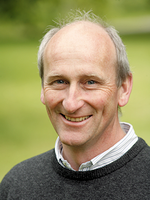Episode 12: End storage of greenhouse gases?
Wood, humus or high-tech for long-term carbon storage.
19.01.2023

About ten percent - that's how many greenhouse gas emissions will remain from the current ones if Germany is climate neutral by the middle of the century. This is because there will be unavoidable emissions that will have to be compensated. This works, for example, by removing carbon dioxide (CO2) from the atmosphere and storing it permanently. But where should the CO2 go? And which CO2 extraction processes are at all promising?
„For our 2050 vision - and this is an optimistic vision - we have said for the peatlands and organic soils, we re-water everything we have in Germany and thereby achieve CO2 avoidance in agriculture.“
Dr. Nadine Mengis, Geomar Helmholtz Centre for Ocean Research Kiel
Currently, only forests and wood products form a so-called carbon sink in Germany. Through their metabolism, trees bind about seven percent of German CO2 emissions. Worldwide, the figure is more than 25 percent. That is why hopes on the path to a climate-neutral lifestyle rest primarily on forests. However, great potential is also attributed to agriculturally used soils, because humus, for example, is also one of the carbon reservoirs.
Possibilities and ideas for man-made CO2 sinks are, on the one hand, increased building with wood, because carbon can remain fixed in durable wood products for many decades. On the other hand, there are longer-term ideas, such as combining bioenergy with "capture and storage". The carbon dioxide would then be captured and stored directly at the chimney instead of being released into the surrounding air. The targeted stabilisation of plant biomass through the production of pyrolysis charcoal is also being discussed as a possible long-term carbon sink. Last but not least, there are ideas and attempts to pull carbon dioxide out of the atmosphere or even the sea with the help of CO2 filter systems and then store it geologically, for example in disused natural gas reservoirs.
What contributions to carbon storage agriculture and forestry can actually make, why peatlands and oceans play such an important role in CO2 storage, what possibilities CO2 filter plants offer and why there is nevertheless no way around avoiding greenhouse gas emissions are discussed by our guests in this episode: Dr Nadine Mengis from the Geomar Helmholtz Centre for Ocean Research Kiel, Prof. Andreas Krause from the Thünen Institute of Wood Research and Prof. Heiner Flessa from the Thünen Institute of Climate-Smart Agriculture.
Sources and further readings
- Study on the carbon storage potential of soils
- Climate Protection through CO₂ Certificates for Humus
- Thünen explains: Why Forest Use is also Climate Protection
- Project: Potentials of biochar as negative emission technology
- MacDougall AH, Mallett J, Hohn D, Mengis N. (2022) Substantial regional climate change expected following cessation of CO2 emissions. Environmental Research Letters, 17 (11). Art.Nr. 114046. DOI 10.1088/1748-9326/ac9f59
- Evaluation of potential CO2 removal processes

Climate physicist Dr Nadine Mengis is an expert in the evaluation of CO2 removal processes. She heads the Emmy Noether working group of the FOOTPRINTS project at the Geomar Helmholtz Centre for Ocean Research Kiel. Together with researchers from the Helmholtz Climate Initiative, she has calculated how Germany can achieve net zero CO2 emissions by 2050.

Professor Heinz Flessa, head of the Thünen Institute of Climate-Smart Agriculture, is primarily concerned with agriculture and climate protection. As a soil specialist, he knows the dynamics of carbon and nitrogen in soils and researches soils as sources and sinks for climate-relevant trace gases.







